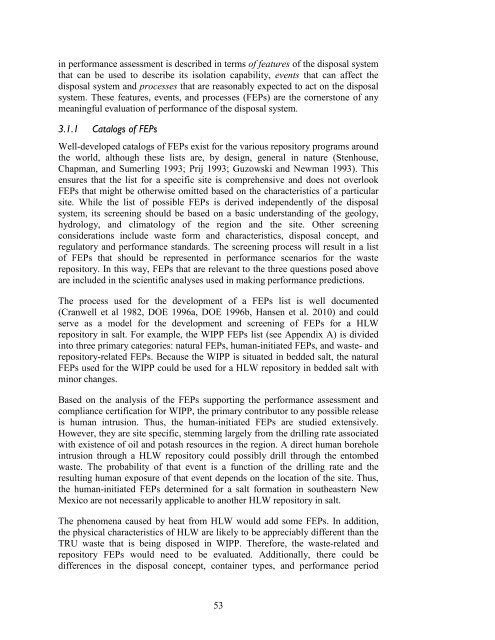Salt Disposal of Heat-Generating Nuclear Waste
Salt Disposal of Heat-Generating Nuclear Waste
Salt Disposal of Heat-Generating Nuclear Waste
Create successful ePaper yourself
Turn your PDF publications into a flip-book with our unique Google optimized e-Paper software.
in performance assessment is described in terms <strong>of</strong> features <strong>of</strong> the disposal system<br />
that can be used to describe its isolation capability, events that can affect the<br />
disposal system and processes that are reasonably expected to act on the disposal<br />
system. These features, events, and processes (FEPs) are the cornerstone <strong>of</strong> any<br />
meaningful evaluation <strong>of</strong> performance <strong>of</strong> the disposal system.<br />
3.1.1 Catalogs <strong>of</strong> FEPs<br />
Well-developed catalogs <strong>of</strong> FEPs exist for the various repository programs around<br />
the world, although these lists are, by design, general in nature (Stenhouse,<br />
Chapman, and Sumerling 1993; Prij 1993; Guzowski and Newman 1993). This<br />
ensures that the list for a specific site is comprehensive and does not overlook<br />
FEPs that might be otherwise omitted based on the characteristics <strong>of</strong> a particular<br />
site. While the list <strong>of</strong> possible FEPs is derived independently <strong>of</strong> the disposal<br />
system, its screening should be based on a basic understanding <strong>of</strong> the geology,<br />
hydrology, and climatology <strong>of</strong> the region and the site. Other screening<br />
considerations include waste form and characteristics, disposal concept, and<br />
regulatory and performance standards. The screening process will result in a list<br />
<strong>of</strong> FEPs that should be represented in performance scenarios for the waste<br />
repository. In this way, FEPs that are relevant to the three questions posed above<br />
are included in the scientific analyses used in making performance predictions.<br />
The process used for the development <strong>of</strong> a FEPs list is well documented<br />
(Cranwell et al 1982, DOE 1996a, DOE 1996b, Hansen et al. 2010) and could<br />
serve as a model for the development and screening <strong>of</strong> FEPs for a HLW<br />
repository in salt. For example, the WIPP FEPs list (see Appendix A) is divided<br />
into three primary categories: natural FEPs, human-initiated FEPs, and waste- and<br />
repository-related FEPs. Because the WIPP is situated in bedded salt, the natural<br />
FEPs used for the WIPP could be used for a HLW repository in bedded salt with<br />
minor changes.<br />
Based on the analysis <strong>of</strong> the FEPs supporting the performance assessment and<br />
compliance certification for WIPP, the primary contributor to any possible release<br />
is human intrusion. Thus, the human-initiated FEPs are studied extensively.<br />
However, they are site specific, stemming largely from the drilling rate associated<br />
with existence <strong>of</strong> oil and potash resources in the region. A direct human borehole<br />
intrusion through a HLW repository could possibly drill through the entombed<br />
waste. The probability <strong>of</strong> that event is a function <strong>of</strong> the drilling rate and the<br />
resulting human exposure <strong>of</strong> that event depends on the location <strong>of</strong> the site. Thus,<br />
the human-initiated FEPs determined for a salt formation in southeastern New<br />
Mexico are not necessarily applicable to another HLW repository in salt.<br />
The phenomena caused by heat from HLW would add some FEPs. In addition,<br />
the physical characteristics <strong>of</strong> HLW are likely to be appreciably different than the<br />
TRU waste that is being disposed in WIPP. Therefore, the waste-related and<br />
repository FEPs would need to be evaluated. Additionally, there could be<br />
differences in the disposal concept, container types, and performance period<br />
53
















